#second Empire fashion
Photo
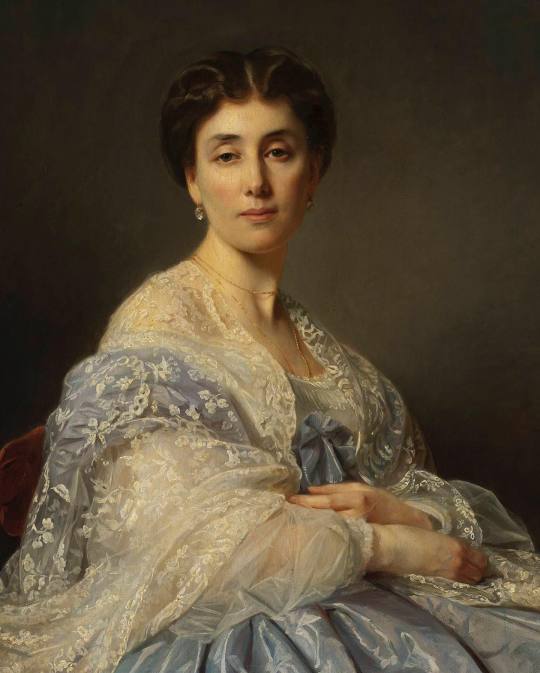
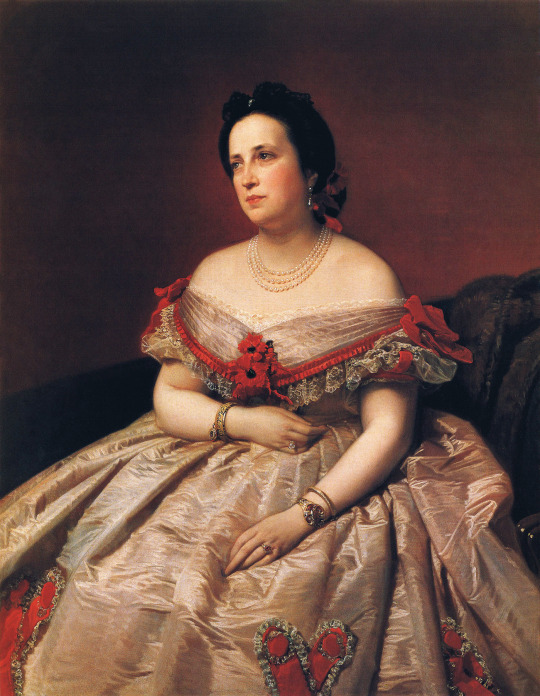


1860s dresses (from top to bottom) -
1862 Aleksandra Zatler, general’s wife, by Josef Simmler (location ?). From Merinok's Facebook pages 1440X1795.
1863 Rosa Guardiola, Baronesa de Andilla by Federico de Madrazo y Kuntz (private collection). From Wikimedia 1400X1804.
ca. 1865-1866 Afternoon dress (auctioned by Tessier-Sarou). From tumblr.com/fashionsfromthepast 1280X1920.
ca. 1867 Walking and visiting suit by Worth & Bobergh (Albany Institute of History and Art - Albany, New York, USA). From tumblr.com/history-of-fashion 1660X3072.
#1860s fashion#early Victorian fashion#Second Empire fashion#Aleksandra Zatler#Josef Simmler#wavy hair#lace wrap#off shoulder neckline#Rosa Guardiola#Federico de Madrazo y Kuntz#off shoulder V neckline#pleated bertha#lace bertha#full skirt#blouse#clerical neckline#bodice#deep V neckline#waist band#crinoline#Worth & Bobergh#high neckline#long full sleeves#bustle#petticoat#under-skirt
97 notes
·
View notes
Text
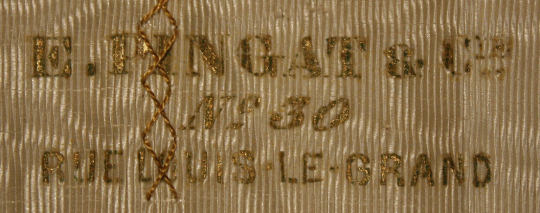
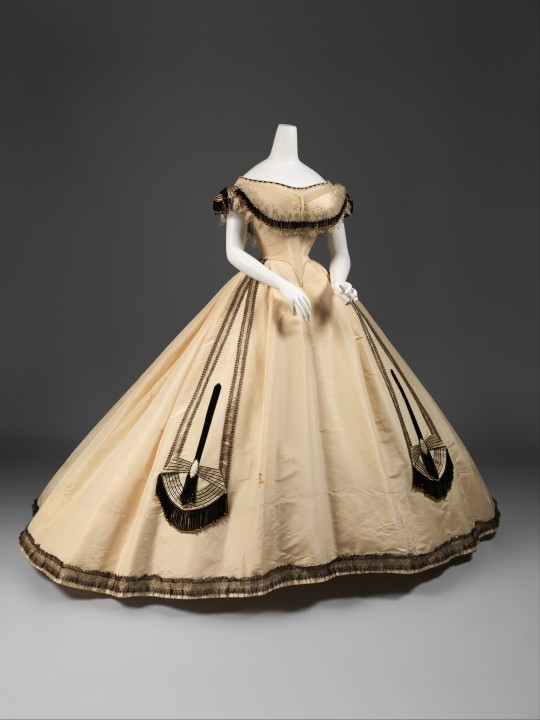
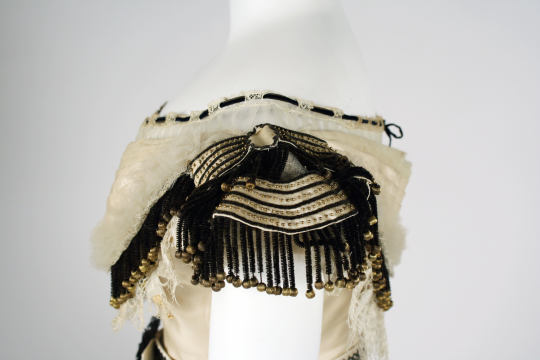

Ball Gown
Emile Pingat (Paris, France)
c.1864
The MET (Accession Number:C.I.69.33.12a–c)
#ball gown#evening dress#1860s#fashion history#historical fashion#emile pingat#pingat#1864#white#black#silk#19th century#second french empire#france#crinoline era#up close#the met
903 notes
·
View notes
Text

Carte de visite of a French naval officer with perfectly curled hair and a matinee idol face, c. 1860s
#squinting at his trousers is that a serendipitously placed lighter spot from the paper foxing with age or is he just very…#well-anchored#I mean there WERE some other definite foxing spots (that I retouched out) but they were more distinct and circular#as always refer solely to seller’s pic if buying#19th century#1800s#1860s#second empire#19th century fashion#fashion history#historical fashion#men's fashion#menswear#uniforms#military fashion#navy#19th century photography#carte de visite#cdv#19th century men
251 notes
·
View notes
Text




Jungle Uniform of the Border Regiment from the British Empire dated to 1945 on display at the Cumbria Museum of Military Life in Carlisle, England
This uniform was worn by Private Vernon Cook from Glagate, Lancaster during their time in the 9th Battalion of the Border Regiment. The 9th Battalion was part fo the Burma Campaign 1944 - 1945 that pushed the Empire of Japan out of British occupied Burma.
The start of the war in Burma went very poorly for the Allies and many lessons were learnt. One lesson was the uniform as many British army and Commonwealth soldiers wore the Khaki Drill uniform that was useful in the desert campaigns like in North Africa but not so much the jungles of Burma. The more camoflaged green uniform and light weight material proved to be more effective as well as easier to produce as it was made locally.
Photographs taken by myself 2023
#uniform#military history#fashion#second world war#british empire#20th century#england#english#cumbria museum of military life#carlisle#barbucomedie
22 notes
·
View notes
Photo

Witch or Sorceress masquerade ball dress by Leon Sault, Paris, 1860s
#witches#sorceress#masquerade#fancy dress#costumes#costume designs#fashion designs#magicians#1860s#19th century#Léon Sault#paris#france#europe#french second empire#watercolor#pencil#drawings#historical fashion
290 notes
·
View notes
Photo

Circa 1860 dress with crinoline walk or indoor printed bunting bayadère dating from the French Second Empire
148 notes
·
View notes
Photo
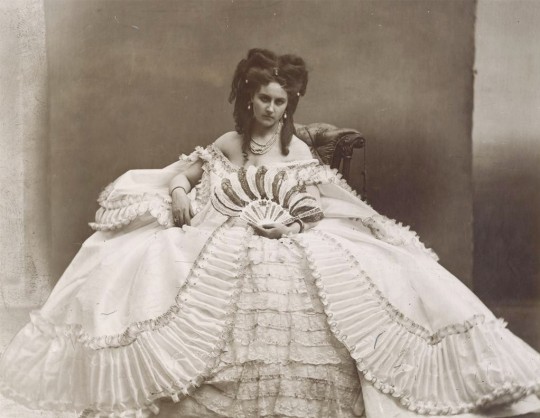
"Infatuated with herself, always classically draped, her magnificent hair her only coiffure, she was strange in her personality and her ways. She would appear at gatherings like a goddess descending from the clouds. At her request, her husband would lead her to a quiet corner of the room where she would allow people to admire her as if she were a shrine; absent amid the crowd, she would meet with glacial calm the indiscreet stares of her admirers (...)”
General Fleury on Virginia Oldoini, Countess di Castiglione
#fierce#virginia oldoini#countess of castiglione#countess di castiglione#pierre louis pierson#historical photography#historicwomendaily#history#photography#women in history#beauty#courtesans#courtesan#victorian era#second empire#fashion#model#hulderposts
192 notes
·
View notes
Photo
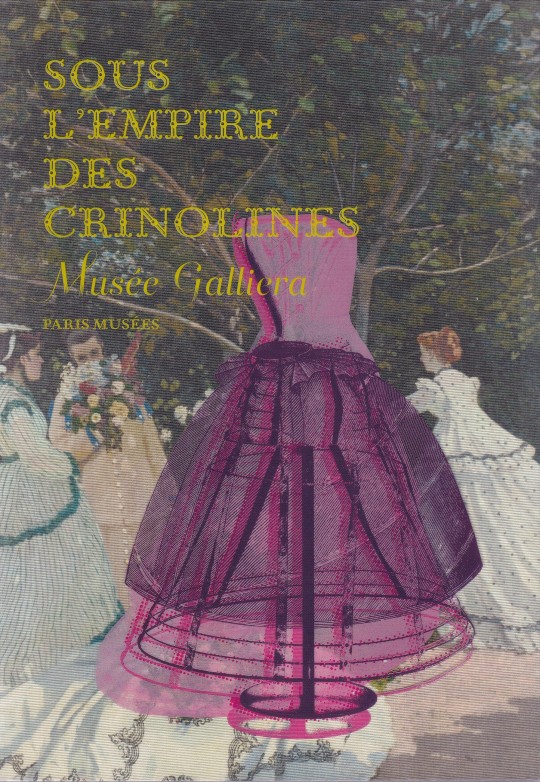
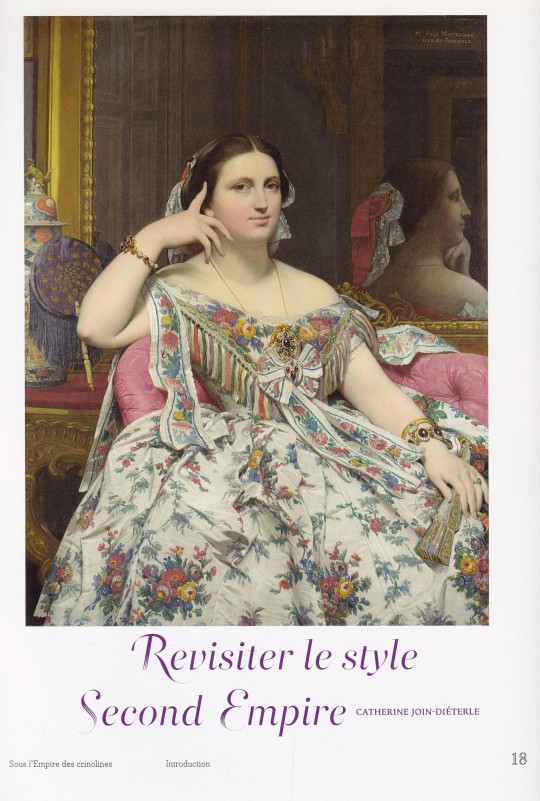


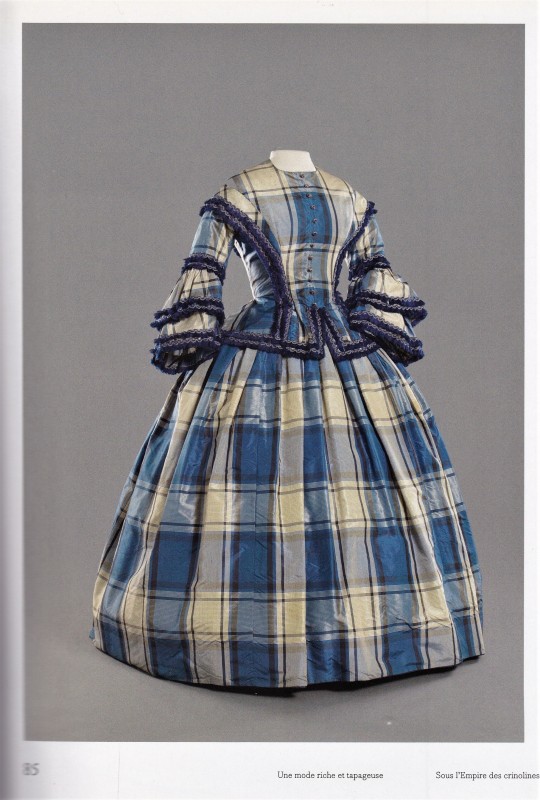
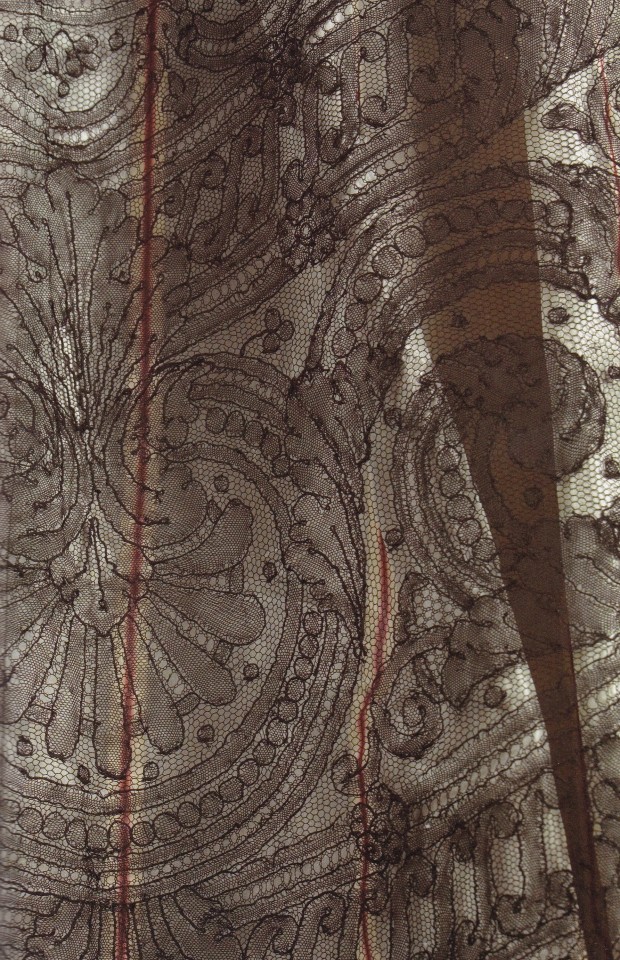

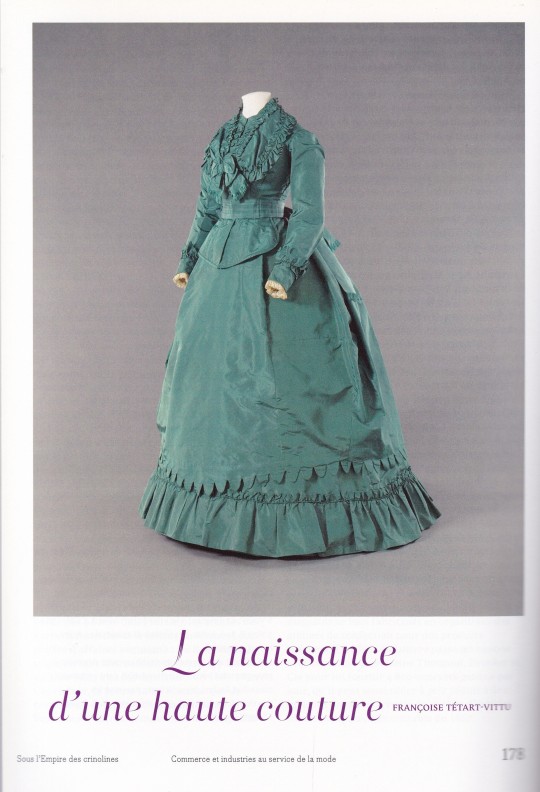
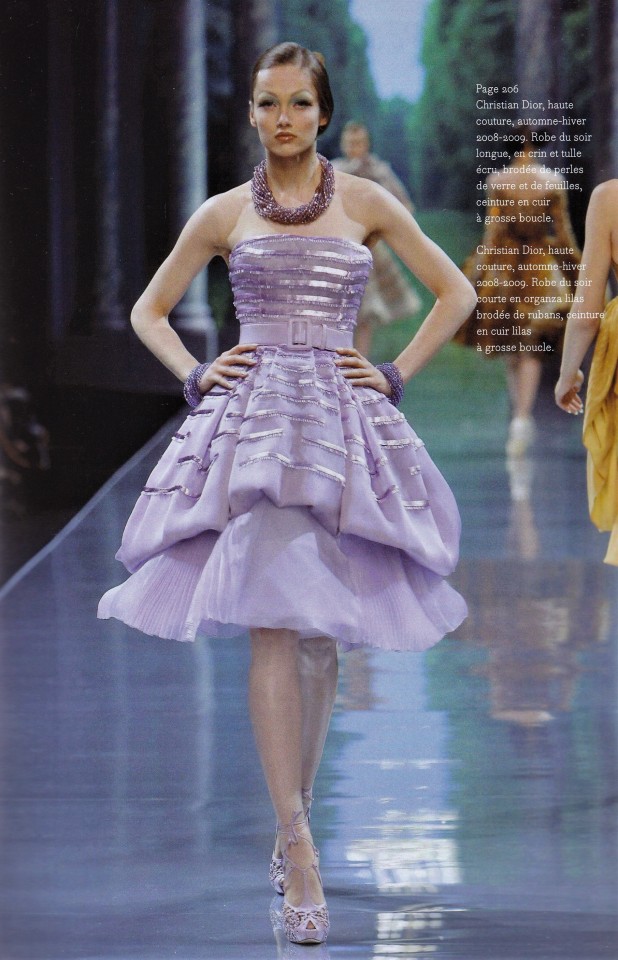

Sous l’Empire des crinolines Musée Galliera
Catherine Join-Diéterle, Françoise Tétart-Vittu
Paris Musées, Paris 2008, 212 pages, Relié, 180 ill.couleurs, 17,5 x 24,5 cm, ISBN : 978-2-7596-0069-4
euro 80,00
email if you want to buy [email protected]
Catalogue publié à l'occasion de l'exposition "Sous l'empire des crinolines" présentée au Palais Galliera du 26 novembre 2008 au 26 avril 2009, Editeur Paris Musées.
Symbole du Second Empire, la crinoline apparaît dès 1830 avec l’utilisation de jupons en crin qui font gonfler les jupes. Ils seront remplacés en 1856 par la fameuse cage à fanons de baleine, puis substitués par une armature métallique. Le succès de cette dernière sera immédiat : en France, 5 millions sont confectionnés en 1860. Sa forme évolue également. D’abord ronde, elle est ensuite plate devant et se projette loin vers l’arrière. Puis, à partir de 1867, une «demi crinoline», plus étroite, s’impose.
Souvent comparée aux coupoles en métal et en verre la crinoline témoigne de la passion de l’époque pour le volume. Cependant, ce qui frappe surtout c’est l’exubérance de la silhouette, l’emploi récurrent des volants, l’accumulation des étoffes et des ornements, l’éclectisme des décors où se mêlent historicisme et orientalisme, où le bleu vif côtoie le rose pastel.
Mais au delà du port de la crinoline, de la rapidité des transformations de la silhouette, de la diversité des sources d’inspiration, la mode du Second Empire reflète les changements survenus en France depuis le début du siècle.
Cet ouvrage richement illustré, témoigne de cette période très particulière dans l’histoire de la mode française. Conçu autour de trois grands thèmes (la fête à la ville et à la cour ; la modernisation ; la commercialisation) il aborde l’ensemble des aspects propres à la crinoline et à son époque. Mais il nous montre également à quel point elle fascine encore les créateurs. Regardons pour cela comment Jean-Paul Gaultier ou John Galliano (pour Dior) l’interprètent dans leurs collections automnes-hivers 2008-2009.
12/05/23
orders to: [email protected]
ordini a: [email protected]
twitter: fashionbooksmilano
instagram: fashionbooksmilano, designbooksmilano tumblr: fashionbooksmilano, designbooksmilano
#Empire Crinolines#fashion exhibition catalogue#Palais Galliera Paris 2008#crinoline#Second Empire#mode française#Jean-paul Gaultier#John Galliano Dior#collection hiver 2008.09#fashion books#fashionbooksmilano
16 notes
·
View notes
Text
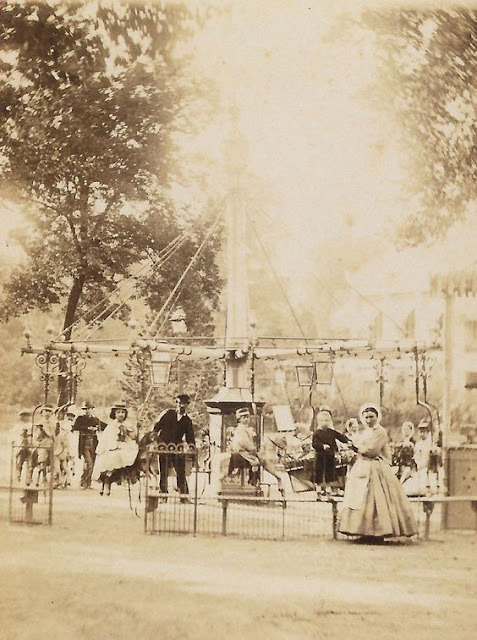
Outdoor carousel, poss. around Champs-Élysées, Paris. ca. 1860s. via eBay.
#paris france#paris#victorian#carousel#second empire#france#french#champs élysées#1860s#1860s fashion#amusement rides#amusement park
10 notes
·
View notes
Text
I swear I don't want to contaminate this blog with the 1850s when there is already way too much 1840s going on, but I can't resist the appeal of loudly patterned midcentury menswear, which honestly seems to peak in the early 1850s.

Circa 1850s caricature by J.V. Barret, Wellcome Collection.

Some Second Empire swells in a fashion plate, 1853 (Met Museum). They gave the child a gun and also made some decisions with facial hair.
I feel that just as the ultimate distillation of the 1980s, the Solo cup Jazz pattern, was actually produced in 1992; and the hippie psychedelic aesthetic that we associate with the 1960s is more of an early 1970s thing—so the long and stripey shadow of the Greater 1840s persists into the 1850s.
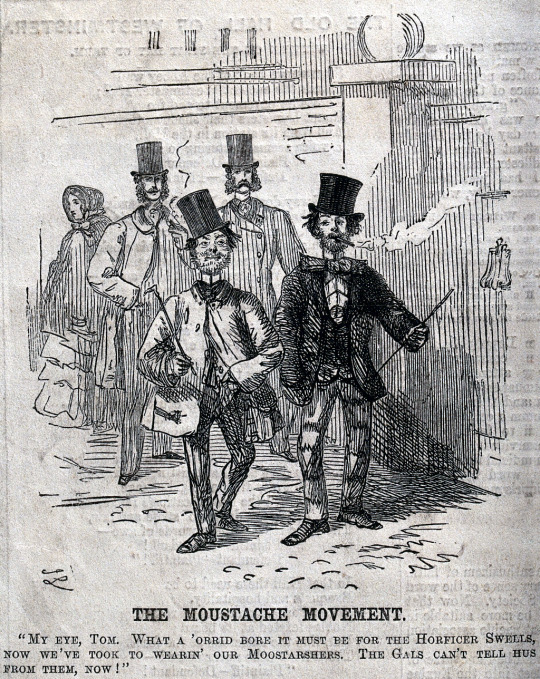
An 1854 cartoon by John Leech that the Wellcome Collection describes as "Two working-class men wearing top hats and moustaches, imitating the fashions of the upper classes, rejoice in their new-found equality in fashion."
There are 1850s cartoons in a similar vein by Leech on the John Leech Archive, but not in high resolution.


Two 1854 cartoons by Leech showing that the "Gent" of the 1840s is alive and well: striped pants, narrow-brimmed hat, paletot coat and all.
#1850s#fashion history#dress history#historical men's fashion#men's fashion#victorian era#second empire#john leech#fashion plate#1854#gents#fashion#stripes stripes and stripes
40 notes
·
View notes
Photo
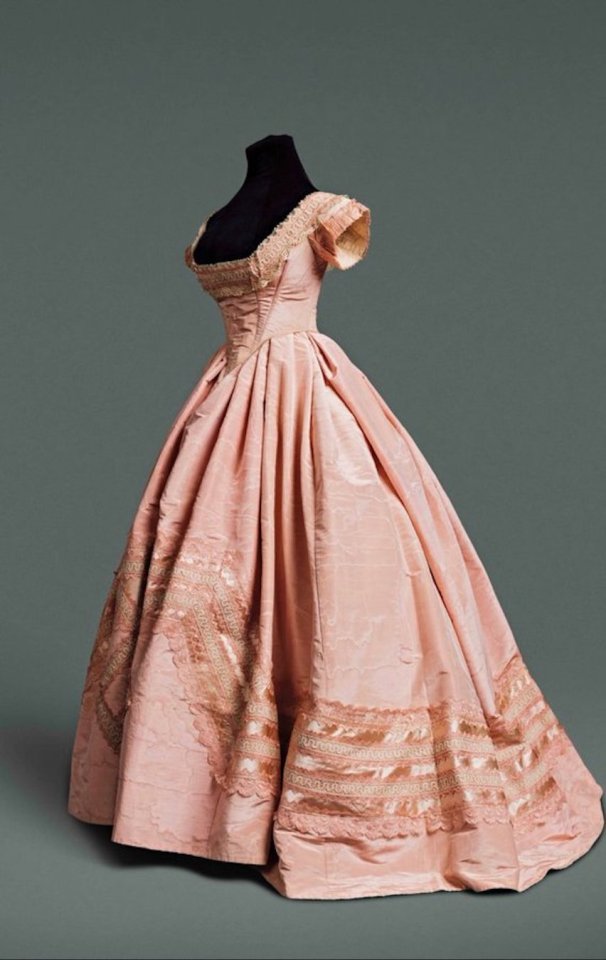
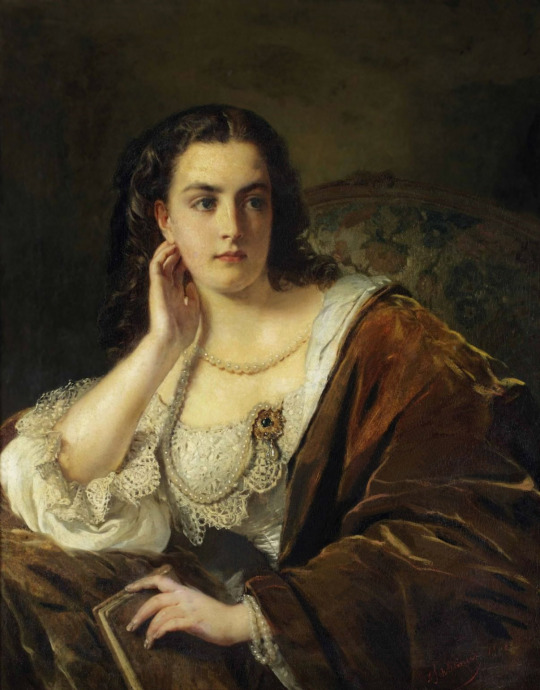
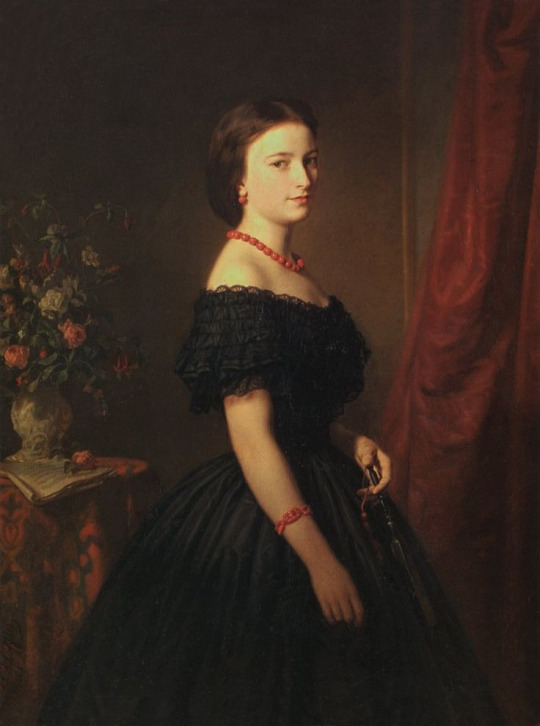
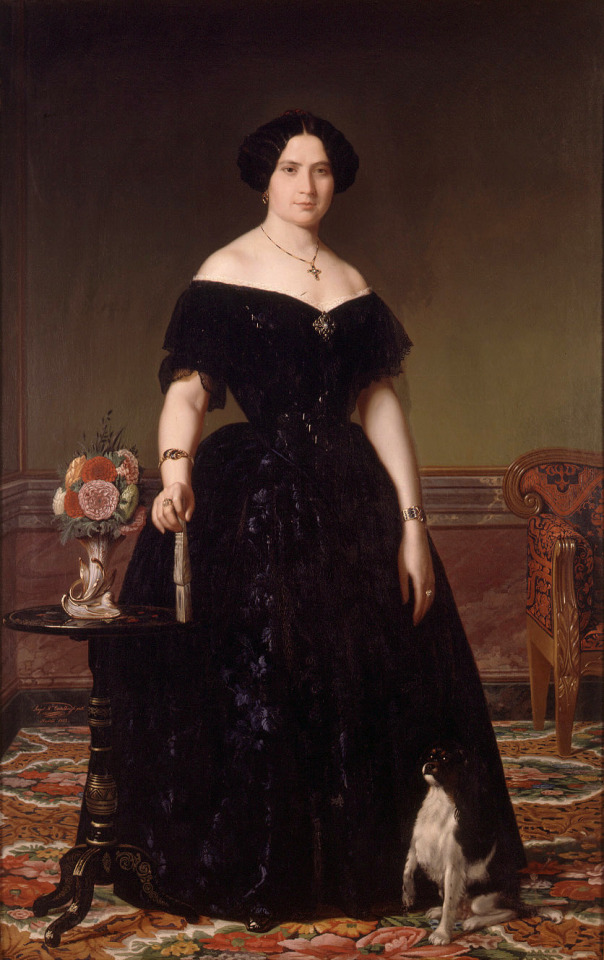

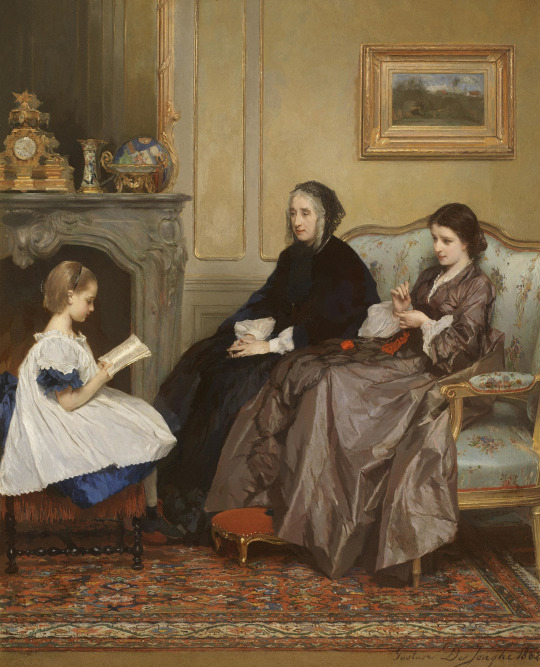
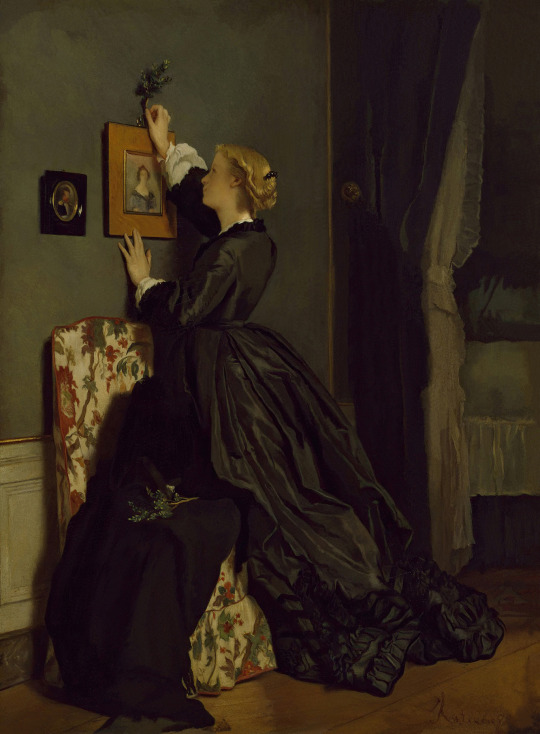
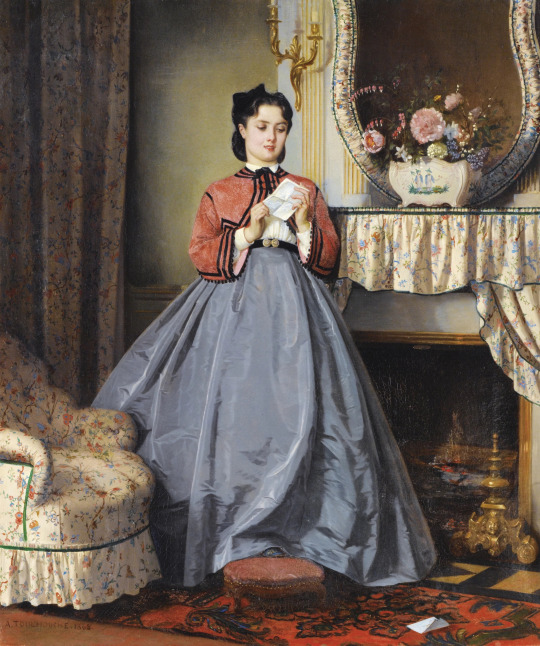
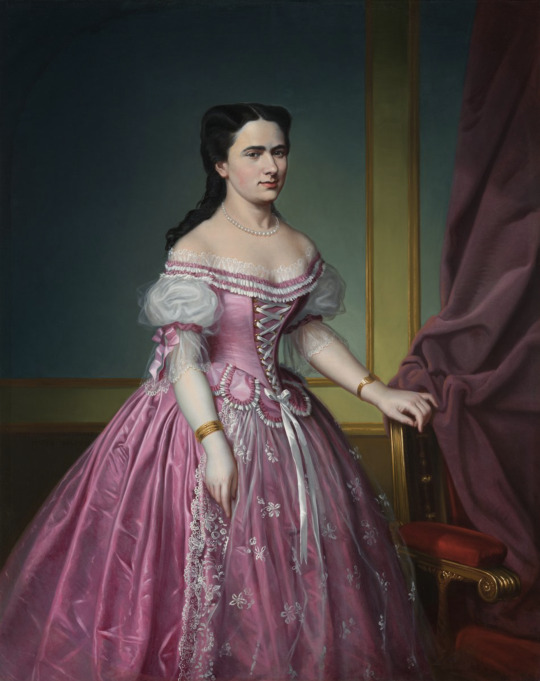
Back to the 1860s -
Top row 1860 Ballgown (location ?). From tumblr.com/royaland; enlarged by half 852X1350.
Second row 1860 La Contemplation by Henri-Guillaume Schlesinger (location ?). From tumblr.com/artthatgivesmefeelings 1206X1540.
Third row left 1861 Maria Sawiczewska by Leopold Loeffler (location ?). From tumblr.com/ artthatgivesmefeelings; fixed larger spots & edges w Pshop 736X989.
Third row right ca. 1860 Doña Antonia Roca by Ángel María Cortellini y Hernandez (Museo de Bellas Artes de Valencia - Valecia, Valencia, Spain). I found this before I started recording sources - before 2010; fixed spots & flaw w Pshop 836X1328.
Fourth row left 1862 The lesson, mother and her daughter in a bourgeois interior by Gustave Léonard de Jonghe (location ?). From tumblr.com/artthatgivesmefeelings; fixed spots & large smudge w Pshop 1920X1557.
Fourth row right 1862 The recital by Gustave Léonard de Jonghe (location ?). From Wikimedia; fixed spots w Pshop 1657X2047.
Fifth row 1862 Palm Sunday by Alfred Stevens (location ?). From tumblr.com/eirene; fixed spots & flaws w Pshop 1367X1859.
Sixth row left 1863 The Love Letter by Auguste Toulmouche (Sotheby's - Auction PF1209 Lot 135). From their Web site; too many flaws to fix 2836X3391.
Sixth row right 1865 Erzsébet Borsay by Ferenc Klimkovics (Magyar Nemzeti Galéria - Budapest, Hungary). From en.mng.hu/artworks/portrait-of-erzsebet-borsay/1894X2390.
#1860s fashion#early Victorian fashion#Second Empire fashion#square décolletage#V waistline#full skirt#Henri-Guillaume Schlesinger#lace bertha#long hair#Maria Sawiczewska#Leopold Loeffler#coral jewelry#off shoulder V neckline#Antonia Roca#Ángel María Cortellini y Hernandez#Gustave Léonard de Jonghe#hair net#V neckline#net mantle#petticoat#shoes#lace cap#long puffed sleeves#Alfred Stevens#hair jewelry#Auguste Toulmouche#zouave jacket#blouse#belt#Erzsébet Borsay
40 notes
·
View notes
Text
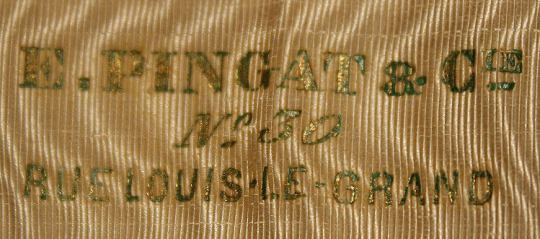

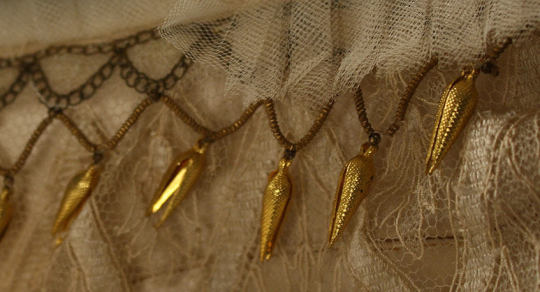
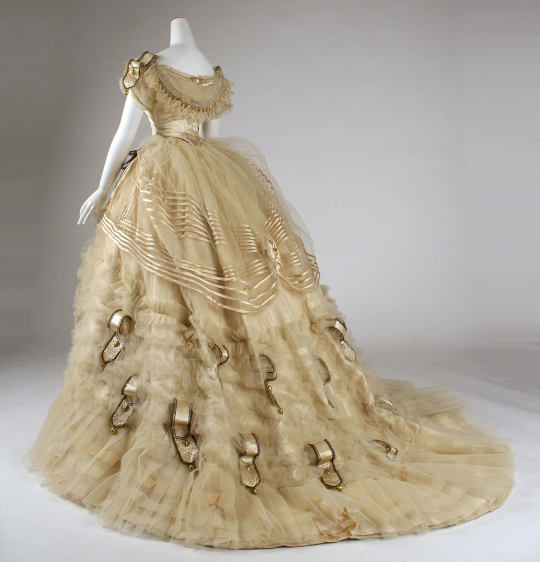
Ball Gown
Emile Pingat (Paris, France)
c.1864
The MET (Accession Number: C.I.69.33.1a, b)
#ball gown#evening dress#1860s#fashion history#historical fashion#up close#pingat#emile pingat#france#silk#second french empire#19th century#crinoline era#1864#the met#playing a bit with my layouts
411 notes
·
View notes
Photo
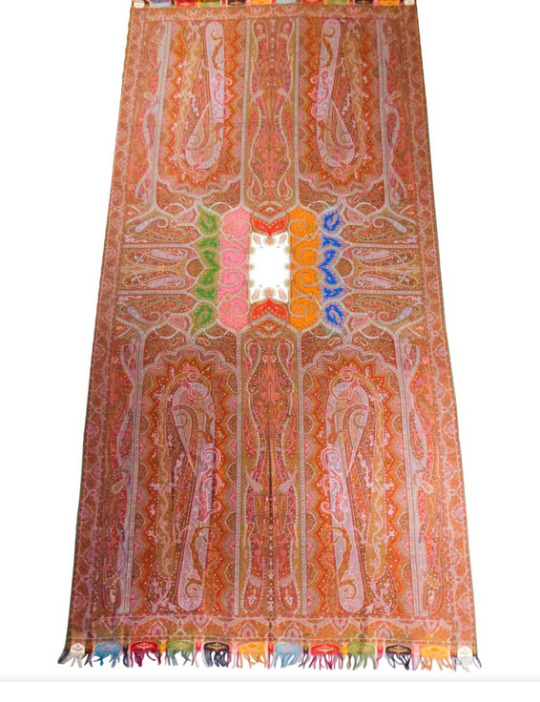


Woven, Not Printed: A Paisley Shawl from 19th Century Paris
Earlier this week, I was admiring the many beautiful printed designs on silk and rayon scarves offered up in the book Scarves. They were printed designs and for some reason when I saw this long shawl on 1st Dibs, I assumed it was printed too. How else could they have used so many colors in so many intricate patterns? The answer is a jacquard loom using 8 different colors. See the last image for the back side of this shawl where the non-dominant colored threads are hidden behind.
They date it to around 1860, so from the Second French Empire. Paisley patterns, borrowed from India, were already fashionable then. While we often see stoles of 6 feet in length and a foot and a half in width today, this one is a whopping size. Almost 5 feet wide and more than 10 feet long. So long that you wonder if anyone actually wore it-- I know I would feel swamped by it, even if it is indeed thin--or if it was used to drape over a sofa instead.
You can find it here: https://www.1stdibs.com/fashion/clothing/coats-outerwear/long-french-paisley-shawl-polychrome-center-circa-1860/id-v_6601412/
#shawls#paisley shawl#vintage shawl#jacquard loom#jacquard#second french empire#1stdibs.com#stoles#vintage stoles#costume history#dress history#fashion history
12 notes
·
View notes
Text

Carte de visite of a sleekly polished gentleman, backstamped Angers, France c. 1860s
#nowadays I try to follow an orderly file naming convention but this had been saved years ago as “caneslut.jpg” and you know what#I wasn’t wrong#19th century#1800s#1860s#19th century fashion#1860s fashion#fashion history#historical fashion#men's fashion#menswear#second empire#19th century photography#cdv#carte de visite#19th century men#vintage men
129 notes
·
View notes
Text



Land Army Uniform from Carlisle, England dated to 1939 on display at the Tullie House Museum and Art Gallery in Carlisle, England
This uniform belonged to Ann Penrice to work on the farms in the Wigton area during the Second World War. She was born in Workington and live in Carlisle. Ann was a "Land Girl" in the Women's Land Army for many years and the bands mark her length of service.
The Women's Land Army was set up to support the agricultural industry in Britain while many men were fighting in the Second World War. They worked all over the country and in all weathers and conditions with little training or preperation for these tasks. Despite ensuring the steady supply of food and the maintenance of natural resources like forests, they were paid much less than men and had to pay for lodging as well. Many also worked with prisoners of war from Italy and Germany.
Photographs taken by myself 2023
#uniform#fashion#20th century#second world war#military history#british empire#england#english#tullie house museum and art gallery#carlisle#barbucomedie
16 notes
·
View notes
Photo

Fancy-dress design representing the Alphabet, Jules Helleu, Paris, 1860s
#fancy dress#costumes#costume designs#Jules Helleu#Paris#france#Second French Empire#19th century#watercolor#1860s#europe#fashion designs#historical fashion
136 notes
·
View notes